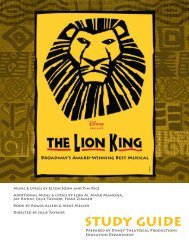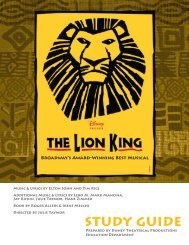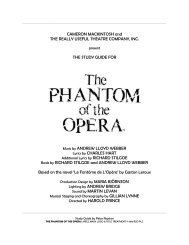Educational Guide - Memphis the Musical
Educational Guide - Memphis the Musical
Educational Guide - Memphis the Musical
You also want an ePaper? Increase the reach of your titles
YUMPU automatically turns print PDFs into web optimized ePapers that Google loves.
Before <strong>the</strong> Show<br />
The Birth of<br />
Rock ‘n’ Roll<br />
Read <strong>the</strong> following article aloud to your class to provide<br />
your students with relevant historical background information.<br />
Have <strong>the</strong>m complete <strong>the</strong> suggested extension activity to<br />
stimulate fur<strong>the</strong>r discussion.<br />
“It’s <strong>the</strong> music of my soul!”<br />
–Huey Calhoun<br />
Rebellious. Driving. Soulful. It was <strong>the</strong> new sound<br />
of a young generation hungry for change. A change that defied <strong>the</strong><br />
rigid structures and conservative standards of Tin Pan Alley, and<br />
syn<strong>the</strong>sized a variety of musical genres into one eclectic sound:<br />
Rock ‘n’ Roll.<br />
In <strong>the</strong> early 1950s, this new sound was considered to be “race<br />
music” as its origins were strongly influenced by <strong>the</strong> black musical<br />
roots of rhythm and blues, soul and gospel. In this era of segregation,<br />
even <strong>the</strong> radio was a venue of divide. Center of <strong>the</strong> dial radio<br />
stations, which were easily accessible, were designated for traditional<br />
music and standards being produced by Broadway composers;<br />
while left of <strong>the</strong> dial, commonly distorted, radio stations were<br />
allotted for black music. This was until a disc jockey by <strong>the</strong> name of<br />
Alan Freed began to play <strong>the</strong> Rock ‘n’ Roll sound as featured music<br />
on his middle of <strong>the</strong> dial radio station in <strong>the</strong> early 1950s. He is also<br />
noted for coining <strong>the</strong> term “Rock ‘n’ Roll.”<br />
Early forms of Rock ‘n’ Roll began with artists like Bill Haley and<br />
<strong>the</strong> Comets, who would often take and adapt <strong>the</strong> earlier works of<br />
black artists. O<strong>the</strong>r artists like Jerry Lee Lewis and Carl Perkins were<br />
able to fuse <strong>the</strong>ir sounds with a country feel. However, <strong>the</strong> sound<br />
found its fa<strong>the</strong>r when a Tupelo, Mississippi truck driver, by <strong>the</strong><br />
name of Elvis Presley, entered <strong>the</strong> scene. Playing his first concert in<br />
1954 in <strong>Memphis</strong>, Tennessee, he not only began to dominate <strong>the</strong><br />
airwaves, but generated much controversy as his voice was often<br />
criticized for sounding too black. However, this didn’t stop his hitera,<br />
spanning from 1954–1963, which resulted in major financial<br />
gains for <strong>the</strong> recording industry and brought Rock ‘n’ Roll into <strong>the</strong><br />
mainstream media.<br />
Extension Activity:<br />
The ABCs<br />
of Rock ‘n’ Roll<br />
Test your students’ knowledge of Rock ‘n’<br />
Roll! Divide your class up into two teams.<br />
Have each team form a line in front of a<br />
large sheet of poster paper with <strong>the</strong> letters<br />
“A” – “Z” written out vertically. On your signal,<br />
have students race one-by-one to fill-in<br />
words that are relevant to Rock ‘n’ Roll (i.e.<br />
people/bands, instruments, songs, etc.)<br />
using each individual letter as <strong>the</strong> start of<br />
a word. (Note: Teams must respond in sequential<br />
order!) The first team to complete<br />
<strong>the</strong>ir chart and sit down in an orderly fashion<br />
wins. After <strong>the</strong> relay, ask your students<br />
to review <strong>the</strong> responses. What are <strong>the</strong><br />
commonalities and differences between<br />
<strong>the</strong> two lists Are <strong>the</strong>ir any responses <strong>the</strong>y<br />
don’t know<br />
National Standards for Learning: NL-ENG.<br />
K-12.4: Communication Skills, NL-ENG.<br />
K-12.11: Participating in Society, NL-ENG.<br />
K-12.12: Applying Language Skills<br />
New York City Department of Education’s<br />
Blueprint for Teaching and Learning in<br />
<strong>the</strong> Arts: BP-T.9-12.1: Theater Making,<br />
BP-T.9-12.3: Making Connections, BP-<br />
M.9-12.2: Music Literacy, BP-M.9-12.3:<br />
Making Connections<br />
© Chris Owyoung 2009<br />
w w w. m e mphis<strong>the</strong>music a l . c o m •





